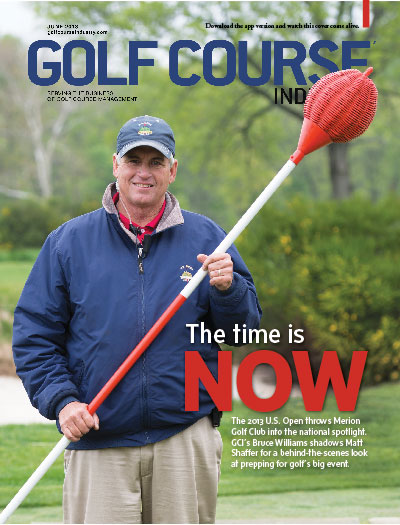 Tim Moraghan Tim Moraghan |
When it comes to your golf course, a picture truly is worth a thousand words. Quality photography is an essential tool for the smart superintendent who wants to document how a maintenance project is progressing, keep track of seasonal changes, show before-and-after situations and make important presentations to committees and ownership. Despite advances in technology, taking good course photos is more than snapping away with your iPhone. It takes skill and some tricks of the trade to take photos that effectively show members what needs to be done, what’s not working (disease, poor root systems, architectural and design issues), and where the club needs to be spending its money (trees, traffic patterns, wear and tear). So I asked two of the world’s best golf course photographers – Joann Dost (joanndost.com) and Larry Lambrecht (golfstock.net) who take those spectacular pictures you see in magazines, advertising, and calendars – for some tips to help us amateur shutterbugs.
JD: In early-morning or evening light; approximately the first 2-3 hours of the morning and the last 2-3 hours of the evening. If your course is heavily wooded, you may have to wait for the sun to get higher in the sky for good results. If possible, shoot a course during the edges of storms: You’re blessed with the most dramatic light, which can turn even the most nondescript hole into a visual gem.
JD: I always try to show the hole with the flag in the green, but it’s not always possible, say I’m shooting from the tee box and the hole is a dogleg. A golf course looks best from a few feet up, so I travel with a special ladder that attaches to a cart and allows me to position the camera 12 to 14 feet above the ground. At this height, I’m able to see most of the subtleties in the design. And I always try to have a point of interest in the foreground: It leads the eye into the image and allows the viewer to travel through the design of the hole. I shoot holes from different angles, not necessarily the way it’s played. For instance, the 18th at Pebble Beach looks spectacular from behind the green and slightly elevated. Be creative to make the image stand out. LL: I try to shoot from the golfer’s perspective. However, the needs of the club and the superintendent don’t always fit this view. The superintendent has to review the purpose of the vision he is trying to project, whether it’s irrigation, tree clearing, bunker removal, or cut lines in the fairways. If you’re taking the photos, spend some time on the site first and pick the best time of the day to enhance your project.
JD: I need to know the maintenance schedule so I don’t arrive when something major is happening, such as green aerification or top dressing. Then I keep the superintendent informed on what I’m doing so I can get out in front of the crew in the morning and keep working into the evening without the sprinklers going off or other maintenance issues in my shots. The real balancing act is working between maintenance and normal play. When I’m on site for a photo shoot, over three or four days I’ll go around a course at least 10 times a day learning the maintenance short cuts and subtle nuances. In shooting mode I need to be able to get to the correct position as quickly as possible, depending on the light. Time is of the essence, so when you are well prepared and understand the layout you can be so much more productive. I try to take shots with the superintendent and owner in mind. It is their course and I want to make it look the best I can for them, consequently it helps to be able to go around the course with the superintendent and/or owner to see what he wants to show or not show. I don’t like to rely on PhotoShop to correct problems in the field. I try and correct things before I shoot. If a bunker is not raked, I have a leaf rake with me so I can rake it. LL: In this age of computers, there isn’t anything that gets in the way of taking a good shot with the right light. Software today in the right hands can fix ground under repair, divots, remove golfers, rakes, signs, and power lines. But remember, the most important features of a good photo are the composition and the lighting of Mother Nature. Those are things a computer cannot accomplish.
|

Explore the June 2013 Issue
Check out more from this issue and find your next story to read.
Latest from Golf Course Industry
- Gamble Sands to open Scarecrow in 2025
- Toro preps for irrigation, lightning leadership transition
- Triple the trying times
- Honda introduces new battery-powered mowers
- USGA awards IDEA grants to local programs
- MGI Golf launches short-term electric caddy fleet program
- Audubon International adds board members
- WEBINAR: Protect those roots





